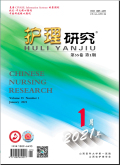护理研究2024,Vol.38Issue(1):17-23,7.DOI:10.12102/j.issn.1009-6493.2024.01.003
甲型流感病毒合并多重感染的临床特征
Clinical characteristics of influenza A virus co-infection with multiple infections
摘要
Abstract
Objective:To investigate the results of respiratory pathogenetic surveillance of patients after novel coronavirus pandemic infection(2023)and to compare them with the pre-epidemic(2018-2019)and intra-epidemic(2020-2022)results,and to analyze the changes in the trend of respiratory viral infections and the clinical characteristics of influenza A virus(IFVA)and mixed infections.Methods:The peripheral blood pathogen IgM test results of 2902 patients with respiratory diseases who attended the First Hospital of Shanxi Medical University from February to March 2023 and those who attended the same period of time before(n=1216)and during the epidemic(n=3113)were collected and analyzed,and the positive patients were classified into the IFVA group according to the infection status,IFVA+Mycoplasma pneumoniae(MP),IFVA+Respiratory Syncytial Virus(RSV),and IFVA+Influenza B Virus(IFVB)groups,and the clinical characteristics and blood routine of the mixed infection groups were compared with those of the simple infection groups.Results:In the serum of 2902 respiratory infection patients in 2023,the number of positive cases for pathogen IgM detection was 1207,among which IFVA-IgM had the highest positive rate,with a total of 393 cases detected with a combination of two or more antibodies;During the epidemic,the serum IgM test results of 3113 respiratory infection patients showed a positive number of 794 cases,among which IFVA-IgM had the highest positive rate,with a total of 194 cases detected by a combination of two or more antibodies;before the epidemic,the serum IgM test results of 1216 respiratory infection patients showed a positive number of 393 cases,of which IFVA-IgM had the highest positive rate,and a total of 63 cases were detected with two or more antibody combinations.The results of Logistic regression analysis showed that age is an independent influencing factor of IFVA+MP,while age and platelet count(PLT)are independent influencing factors of IFVA+RSV;Elevated PLT,shortness of breath and chest tightness,and the presence of underlying diseases are independent influencing factors of IFVA+IFBV.In the receiver operating characteristic(ROC)curve,the area under the ROC curve for age predicted IFVA+MP is 0.715(95%CI 0.657-0.773).The area under the ROC curve for age prediction of IFVA+RSV is 0.742(95%CI 0.690-0.794).Conclusion:Strict precautionary measures during novel coronavirus infection can curb the spread of respiratory pathogens.Control measures can contain the spread of respiratory pathogens.After the widespread infection of novel coronavirus,people's immunity level generally decreases,which makes them more susceptible to viral infections and mixed infections.Clinicians can predict the occurrence of mixed infections based on patients' clinical symptoms,signs and laboratory tests,and provide symptomatic treatment in a timely manner.关键词
呼吸道病毒/流感病毒/混合感染/病原学检测/流行特征Key words
respiratory virus/influenza virus/mixed infection/pathogenic testing/epidemic characteristics引用本文复制引用
刘宁静,贾艳霞,耿晓丽..甲型流感病毒合并多重感染的临床特征[J].护理研究,2024,38(1):17-23,7.基金项目
中华国际科学交流基金会项目,编号:Z2020LSXD07 ()
山西省回国留学人员科研项目,编号:2020-166 ()

